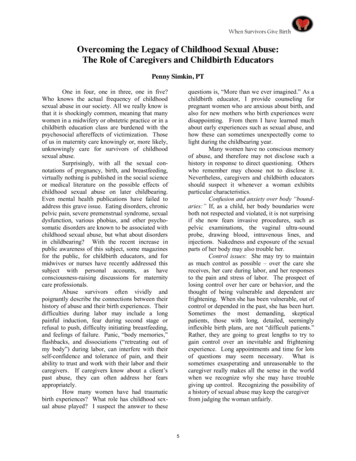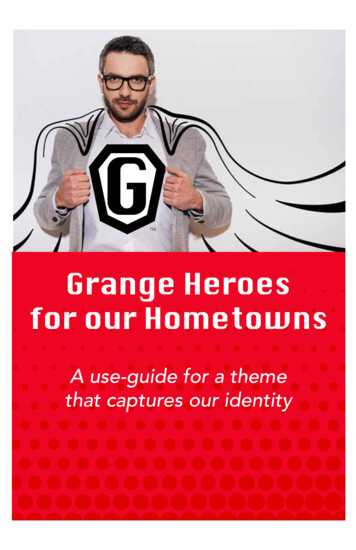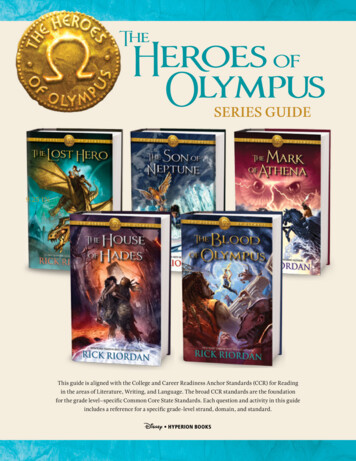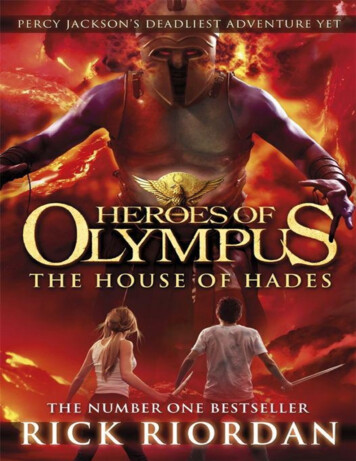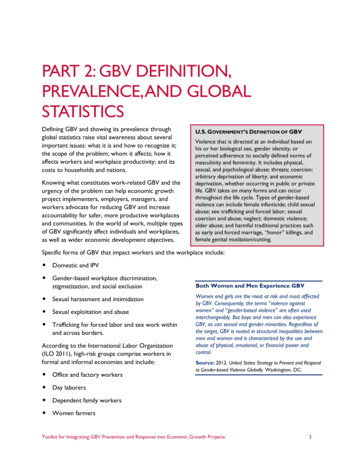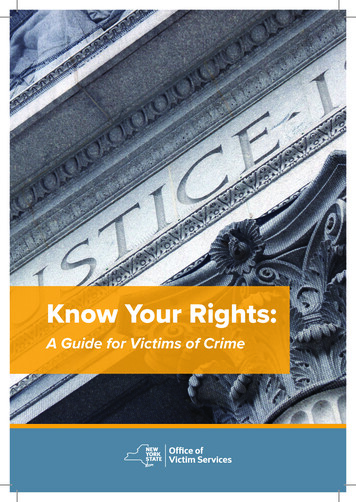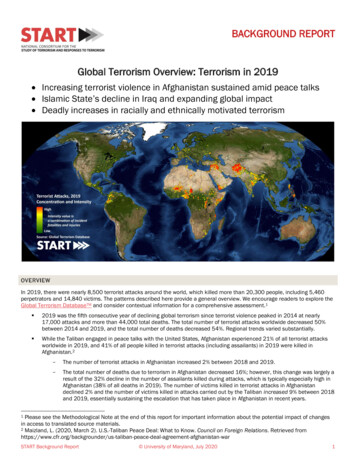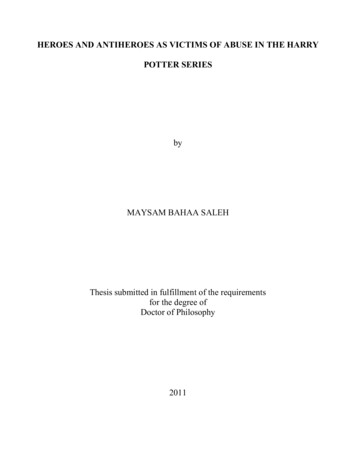
Transcription
HEROES AND ANTIHEROES AS VICTIMS OF ABUSE IN THE HARRYPOTTER SERIESbyMAYSAM BAHAA SALEHThesis submitted in fulfillment of the requirementsfor the degree ofDoctor of Philosophy2011
ACKNOWLEDGEMENTSFirst of all, I would like to thank Allah (Subhanahu Wa Ta’ala) for giving me thestrength, patience and courage to complete my study. Without His mercy, I would neverbe able to accomplish this research.My sincere appreciation and gratitude to my supervisor, Dr. Agnes Liau Wei Lin,for her invaluable advice and guidance throughout the course of the study. I want also tothank my ex- supervisor Dr. Azlena Zainal for her great effort in helping me to choosethe topic of the study and her tolerance until I found the end of the tunnel.I want also to thank my family and my beloved husband for their patience,support, sacrifice and love throughout my study. It would be impossible to accomplishmy research without their prayers for me.Special thanks to the USM Hamzah Sendut Library 1 & 2 for their great help inproviding me with the access to the databases and important references that helped me alot in my study. I would like also to thank all my colleagues and friends for their effortand support, and my gratitude to the School of Humanities, USM, for giving me thechance to complete my studies under their guidance and supervision.ii
TABLE OF CONTENTSPageAcknowledgment . iiTable of Contents . . iiiList of Figures . . viiList of Abbreviations . viiiAbstrak .ixAbstract. . .xiiCHAPTER 1 – INTRODUCTION1.1 Introduction. 11.2 The Statement of the Problem.91.3 The Objectives.141.4 The Research Questions.151.5 Significance of the Study.161.6 Limitations of the Study.181.7 Definition of Terms.181.8 The Harry Potter Series.251.9 The Writer.281.10Summary.30iii
CHAPTER TWO – LITERATURE REVIEW2.1 Child Abuse in Children’s Literature.322.2 Heroes and Antiheroes as Victims of abuse in Literature.432.3 Heroes and Antiheroes as Victims or Villains.452.4 Child Abuse and the Harry Potter Series.492.5 Archetypal Psychology.572.6 The Types and Effects of Child Abuse.662.7 Bullying and Mobbing.692.8 The Residual Effects of Abuse.772.9 Summary.82CHAPTER THREE – METHODOLOGY3.1 Introduction.853.2 The Conceptual Framework.883.3 Summary.94CHAPTER FOUR – HEROES VS. SHADOWS: A PROCESS TOWARDS SELFREALIZATION4.1 The Child Hero.96iv
4.2 Heroes and Villains.1024.3 Severus Snape: A Controversial Character.1144.4 Lord Voldemort as the Shadow.1244.5 Summary.136CHAPTER FIVE – CHILD ABUSE: A REAL PROBLEM IN A FICTIONALWORLD5.1 Child Abuse: Its Types and Instances in the Harry Potter Series.1395.2 Victims of Abuse: Everlasting Scars.1475.3 Abuse, Bullying and Mobbing.1655.3.1 The Bully.1765.3.2 The Victim.1775.4 The School of Hogwarts: A Problem of Safety.1815.5 Silence and Neglecting the Problem of Abuse.1835.6 Summary.185CHAPTER SIX – NEGATIVE AND POSITIVE EFFECTS: A BATTLE OFCHOICES6.1 The Effects of Abuse in the Harry Potter Series .1876.2 The Effects of Abuse on Harry.195v
6.3 The Effects of Abuse on Snape.1996.4 The Effects of Abuse on Voldemort.2026.5 Summary.207CHAPTER SEVEN – CONCLUSIONS AND RECOMMENDATIONS7.1 Introduction .2097.2 The Findings of the Study.2127.3 Recommendations for Future Research.2237.4 Summary.224REFERENCES .225LIST OF PUBLICATIONS.235vi
LIST OF FIGURESPageFigure 2 The Bullying Circle: Students’ modes of reaction/roles in an acute bullyingsituation. (Olweus, 2001, p. 15)73Figure 3 The Conceptual Framework of the Study.92Figure 5.1 The Bullying circle of Harry as the victim and Dudley as the main bully.169Figure 5.2 The Bullying circle of Harry as the victim and Draco as the main bully.170Figure 5.3 The Bullying circle of Snape as the victim and James Potter as the mainbully.173vii
LIST OF ABBREVIATIONSAll the texts of the Harry Potter series are abbreviated from:Harry Potter and the Philosopher’s Stone to: The Philosopher’s StoneHarry Potter and the Chamber of Secrets to: The Chamber of SecretsHarry Potter and the Prisoner of Azkaban to: The Prisoner of AzkabanHarry Potter and the Goblet of Fire to: The Goblet of FireHarry Potter and the Order of the Phoenix to: The Order of the PhoenixHarry Potter and the Half-Blood Prince to: The Half-Blood PrinceHarry Potter and the Deathly Hallows to: The Deathly Hallowsviii
HERO DAN ANTIHERO SEBAGAI MANGSA PENDERAAN DALAM SIRIHARRY POTTERABSTRAKDalam kesusasteraan kanak-kanak, pelbagai tema berkaitan dengan keganasanseperti penganiayaan dan kegiatan membuli telah dikaji. Karya Charles Dickens sepertiOliver Twist dan karya Roald Dahl seperti James and the Giant Peach mencerminkanpenderitaan kanak-kanak sebab watak utama karya-karya ini merupakan anak yatimyang hidup dalam dunia ganas, pada masa yang sama, mereka juga merupakan mangsapenderaan. Siri Harry Potter tidak dikecualikan. JK Rowling menekankan temapenderaan kanak-kanak sejak buku pertama dalam siri ini yang bertajuk Harry Potterand the Philosopher’s Stone (1997) sehingga buku ketujuh bertajuk Harry Potter andthe Deathly Hallows (2007) melalui penggambaran tiga watak, Harry Potter, SeverusSnape dan Lord Voldemort dengan menggunakan pelbagai jenis penderaan sepertipenderaan fizikal, penderaan emosi, penderaan verbal, kegiatan membuli, kegiatanmengerumuni serta pengabaian. Kajian ini akan cuba menerokai setakat mana Rowlingtelah menggambarkan watak-watak ini sebagai hero dan anti-hero yang telah dianiayai,jenis-jenis penderaan yang digambarkan dalam novel serta mengkaji kesan penderaan keatas watak yang didera. Teori ‘archetypal’ Jung (1953) akan diadaptasi dalam kajian inidengan menekankan proses individuasi serta integrasi kedua-dua kesedaran danketidaksedaran yang boleh mempengaruhi watak secara positif atau negatif. Kajian iniakan menggabungkan teori ‘archetypal’ dengan klasifikasi penderaan sosiologi sertaix
psikolog, jenis dan kesan penderaan yang diutarakan oleh Briere (1992), Olweus (2001),Tower (2002) dan Eliot (2003) untuk menganalisa personaliti serta kelakuan wataksepanjang siri ini yang boleh dipengaruhi oleh kesan penderaan yang negatif. Watakboleh menjadi mangsa hero, mangsa antihero atau penganiaya, ataupun sesuatu bayang,yang boleh menjadi mangsa atau orang yang melakukan kejahatan.Dengan mengaplikasi teori ‘archetypal’ Jung atas watak Harry, Harry mencapaikeadaan individuasi dengan mengintegrasi kedua-dua kesedaran dan ketidaksedaran dimana memori penderaan Harry yang telah dipendam dipulihkan. Walaupun Harry telahdipengaruhi oleh kesan negatif penderaan, dia diandaikan seorang watak yang tabah.Kesan positif individuasi telah membantu Harry memulihkan dirinya sendiri daripadapenderaan serta kesan kegiatan membuli justeru itu, Harry menjadi hero mangsa danbukan penganiaya.Snape mengalami pergelutan di antara kesedaran dan ketidaksedaran. Memoripenganiayaan dan kegiatan membuli yang dipendam dan dialami oleh Snape membawakesan negatif ke atas kelakuannya tetapi ini tidak menghalangnya dari mencapaiindividuasi. Dia telah dipengaruhi oleh kesan positif individuasi yang telahmembantunya mengatasi masalah psikologinya serta membina keazaman untukmengatasi penderitaannya lalu menukar statusnya dari menjadi antihero Harry kepadaseorang hero. Di sebaliknya, Voldemort mempunyai pergelutan di antara kesedarannyadan ketidaksedarannya yang telah menghalangnya dari menggabungkan kedua-duakesedaran dan ketidaksedaran. Dia tidak dapat membesar secara psikologi; jadi dia tidakdapat mencapai keadaan individuasi. Dia telah dipengaruhi oleh kesan negatif penderaanmanakala kesan positif individuasi tidak mempunyai apa-apa kesa keatasnya. Oleh itux
kesan penderaan telah menyebabkan Voldemort menjadi seorang yang melakukankejahatan yang gemar menganiayai orang lain.xi
HEROES AND ANTIHEROES AS VICTIMS OF ABUSE IN THE HARRYPOTTER SERIESABSTRACTIn children’s literature various themes have been examined in connection withviolence such as abuse and bullying. Charles Dickens’ Oliver Twist and Roald Dahl’sJames and the Giant Peach are examples of children’s suffering since the maincharacters are orphans living in a violent world and who are, at the same time, victims ofabuse. The Harry Potter series are no exception. Since the first book of the series, HarryPotter and the Philosopher’s Stone (1997), until the seventh book Harry Potter and theDeathly Hallows (2007) J.K. Rowling pursued the theme of child abuse through herdepiction of three characters: Harry Potter, Severus Snape and Lord Voldemort by usingdifferent types of abuse such as the physical abuse, emotional abuse, verbal abuse,bullying, mobbing and neglect. The current research explores to what extent Rowlinghas depicted these three characters as victimized heroes and antiheroes, the differenttypes of abuse throughout the novel and examine the effects of abuse on the abusedcharacters. Jung’s (1953) archetypal theory will be adapted in the current study withemphasis on the individuation process and the integration of both the conscious and theunconscious which can affect the characters either negatively or positively. The studywill combine the archetypal theory with the sociological and psychologicalclassifications of abuse as well as the types and effects presented by Briere (1992),xii
Olweus (2001), Tower (2002) and Elliot (2003) to analyze the characters’ personalityand behaviour throughout the series which can be affected by the negative effects ofabuse. Accordingly, the character can turn into a hero victim, antihero victim orvictimizer, or a shadow, which can be a victim or a perpetrator.By applying Jung’s archetypal theory on Harry’s character, Harry reaches theindividuation state by integrating both the conscious and the unconscious in which hissuppressed memories of being abused have been cured. Though Harry has been affectedby the negative effects of abuse, he is considered a resilient character. The positiveeffects of individuation helped him to heal himself from abuse and the effects ofbullying; consequently, Harry was a victim hero rather than a victimizer.Snape has a struggle between the conscious and unconscious. Snape’s repressedmemories of abuse and bullying have negative effects on his behavior but that did notprevent him from reaching individuation. He has been affected by the positive effects ofindividuation which helped him to cure his own psychological problems and developinga will-power to triumph over his torment and change his status from being Harry’santihero into a hero himself. Voldemort, on the other hand, has a struggle between hisconscious and unconscious and that prevented him from integrating both. He could notgrow up psychologically; therefore, he could not reach the individuation state. He wasaffected by the negative effects of abuse while the positive effects of individuation didnot have any influence on him. Thus, abuse’s effects have turned him into a perpetratorwho enjoys victimizing others.xiii
CHAPTER ONEINTRODUCTION“‘Always the innocent are the first victims,’he said. ‘So it has been for ages past, so it isnow.’”(Rowling, Harry Potter and thePhilosopher’s Stone, p.185)1.1.IntroductionAbuse in general and child abuse in particular have been considered as seriousproblems that need attention. Some writers have depicted the abuse problem in theirworks and these include Charles Dickens and Roald Dahl to shed light on how childrenare exploited and abused. (Kornfeld & Prothro, 2003, 2009) Dickens wrote Oliver Twistwhich is about a boy who worked as an apprentice to an undertaker and how he lived inbad conditions there. Cynthia Crosson-Tower (2002, p.10) argues that Dickens “spokeup for child protection” since he was sent by his family at the age of twelve to aworkhouse after his father’s imprisonment and his mother’s rejection of him. It wasthought that Oliver Twist was his “first social protest” and then the novel was followedby many other novels that addressed the problems of abuse and abandoned children.Drew Chappell (2008, p.1) argues that children in children’s literature can usually befound to be neglected and not supported by adults. These children do not seem qualifiedto handle difficult problems but they always come up with a special insight to“deconstruct the adult’s world.” Still, Chappell (2008) assumes that “power and1
authority” which are given to these children characters positions them in a “mythicrather than realistic realm.” (Chappell, 2008, p.1)The characters in the Harry Potterseries might be mythic in having magical powers and participating in magicaladventures but these do not take them far away from dealing with realistic issues such aslove, friendship, hate, violence, death and abuse.Folk and fairy tales are full of abused, abandoned and neglected children andnursery rhymes show traces of them as well. The rhyme about the old woman who livedin a shoe, fed her many children broth without any bread, and whipped them all soundlybefore sending them to bed reflects the living conditions of many children during theindustrial period. Dickens, also, portrayed the conditions of those suffering children whohad to work so as to live. (Metcalf & Meyer, 1992)The main characters in Dickens’ and Dahl’s novels are orphans living in aviolent world and they are victims of neglect and exploitation. The fairy tales long ago,talked about this problem in stories such as Cinderella, Snow White as well as Hanseland Gretel. Hearne (2000, p.1) argues that fairy tales are often “case studies of childabuse,” and the “motif of the persecuted heroine becomes the realistic depiction of anabused child.” Snow White, for example, has been abused by her stepmother, andCinderella has been exposed to disgrace, slavery, neglect and humiliation by herstepmother and stepsisters.Yet, these stories usually end happily and such a focus on resolution andhappiness only points to our deep wish of avoiding unpleasant insights into childhoodexperiences. Zipes (1988, p.1) states that the classical Grimms' stories are based more on2
something adults suppress and are cautious about, which is child abuse and neglect.Thus, if one examines the body of the Grimms' tales, one may find many children whoexperience some form of mistreatment. Many tales begin with children being kidnapped,used or abandoned; for example, abandonment and continual persecution are centralissues in Snow White, and Hansel and Gretel. (1988, p.1)However, Dickens’ Oliver Twist and Roald Dahl’s James and the Giant Peachare examples of the depiction of the hero who happens to be a victim of abuse andneglect. In such works and other literary studies, the main concern was the hero or themain character in the work such as Thomas Carlyle’s Sartor Resartus: On Heroes andHero Worship (1908), Joseph Campbell’s The Hero with a Thousand Faces (1968), andVladimir Propp’s Morphology of the Folk Tale (1968). These studies concentrated onthe heroes in particular, their dramatic persona, qualities, quests and adventures.The hero usually has special qualities like nobility, courage, selflessness and lovefor mankind. The hero is usually victimized by another character that can be called theantihero. The antihero is the character that does not have the heroic qualities that areexpected from the hero. He could be the antagonist who is the rival of the hero, or hecould be the villain. (Baldick, 1990; Cuddon, 1977; Harmon, 2003) It is important todifferentiate between the hero and the antihero since they are the main concern of thecurrent study.Carlyle (1908) argued that heroes can be divine and worshipped by theirfellowmen especially in mythology. Here, the hero is the greatest man, or the God whois discovered and then ought to be obeyed by people. The hero can be a prophet, a poet,3
a priest, a writer, or a king, but initially they all have the same qualities like honesty,courage, sacrifice and other exceptional merits which define them as heroes.Campbell (1968, p.30) studied the hero as a monomyth. The monomyth can bedefined as the person that has a standard path for his adventure starting with the“separation,” then “initiation,” and finally the “return.” The hero will venture from hisworld to a supernatural world, and then he will face obstacles and problems that aresolved and battles that are won. Finally, he will return to his people with great victoryand wisdom.Campbell (1968, p.38) has discussed the mythical heroes, fairytale heroes, andtheir achievements. He argues that the fairytale hero accomplishes “microcosmictriumph”, while the hero of myth achieves “macrocosmic triumph.” In other words, thereis a young, disgraced and humiliated person who gets special powers that help him todefeat his enemies and in that case he is getting a personal achievement such as power,wisdom, and popularity by defeating his rivals.Vladimir Propp (1968, p. 36) has recognized a type of hero called “victim-hero.”The villain may start the whole problem by banishing or kidnapping the hero and thewhole events of the tale are connected to the hero’s fate, and in that case we have avictimized hero. Propp (1968) stated that the hero is usually the victim, and the villaintries to maltreat and disgrace the hero since he is a major threat from the villain’s pointof view. This study, nevertheless, examined both heroes and antiheroes with more focuson the heroes, and investigated a critical issue in order to find out which heroes arevictims of maltreatment and disdain.4
Literature depicted the problem of abuse as this problem was extracted from reallife. Throughout history children were considered the property of their parents. In earlyRome, the father has all the right to kill, abandon, or sell his child. (Tower, 2002, p.1)There were families who used to kill their disabled infants or the females, andsometimes infanticide was the mother’s solution to her act of shame. (2002, p.1) SanderJ. Breiner (2006) agrees that “we have been abusing, maiming, and killing our childrenfor as long as history has been recorded ” (as cited in Rios, 2006, p. 1) Simultaneously,one of the earlier forms of abuse was child labour or the “indenture” of the parents toapprentice their children to masters who taught them a trade. Usually these mastersenslaved these children and deprived them from their simplest needs such as food andproper shelter. (Tower, 2002, p.4) Metcalf and Meyer (1992, p.1) believe that:violence against children is as diverse as it is ancient, andin today’s global community it takes many forms.Thepowerless in any community are easy targets for abuse, andunder adverse conditions children, who have always beenthe most powerless, bear a double burden of suffering.The National Clearinghouse on Child Abuse and Neglect Information in theUnited States of America has defined child abuse as the “physical injury (ranging fromminor bruises to severe fractures or death) as a result of punching, beating, kicking,biting, shaking, throwing, stabbing, choking, hitting (with a hand, stick, strap, or otherobjects), burning or otherwise harming a child.” (Almond, 2006, p. 14) Child Abuse hasserious physical and psychosocial consequences which adversely affect health. It refersto any act or failure to act that violates the rights of the child, which endangers his or heroptimum health, survival and development. Abuse, however, has been divided into four5
types by Jill Goldman and Marsha K. Salus (2006, p.22): physical abuse, sexual abuse,neglect and psychological or emotional abuse. The World Health Organization (WHO)and the United Nations defined four areas of abuse and neglect: physical, sexual, neglectand emotional abuse. (Corby, 1993; Goldman &. Salus, 2006)To understand what is meant by abuse, one should grasp the meaning of eachcategory of abuse. Goldman and Salus (2006, p. 22-28) stated that physical abuse isconsidered as any physical injury that results from punching, beating, kicking, biting,shaking, throwing, stabbing, choking, hitting, etc. Sexual abuse, on the other hand, isany sexual act, behaviour, or sexual exploitation of the abused. Neglect, however, is themost common type of abuse which can be defined as the failure to provide the child’sbasic needs such as food, shelter, clothes and medical care. Still, there are three kinds ofneglect: physical, educational and emotional neglect. The psychological or emotionalabuse is any behaviour that expresses to the abused that he or she is valueless, unwantedor insignificant in the society. Therefore, ridiculing, terrorizing, threatening, isolatingand restricting the person’s freedom are all types of emotional abuse.Emotional abuse is a pattern of behaviour that hurts the child's emotionaldevelopment or sense of self-worth. This may include constant criticism, threat orrejection, as well as withholding love, support, or guidance. Emotional abuse is almostalways present when other forms are identified. Verbal abuse however, is defined as anybehaviour that shows to others they are bad, have bad qualities and are not accepted bypeople. Goldstein has mentioned four types of verbal abuse: teasing, cursing, gossip andostracism. (Goldstein, 2005, p.1; Rein, 2006, p. 64)6
Furthermore, researchers such as Jill Goldman and Marsha K. Salus (2006, p.28)argued that the psychological or the emotional abuse is the most difficult type to berecognized because its effects such as learning problems, speech disorder and troubles indevelopment can be traced in those who experienced it and those who did not experienceit. Such effects may continue and appear in later stages of the individual’s life. In otherwords, the repercussion of abuse continues from childhood till adulthood, and this iswhat the current study tries to investigate.The current study, on the other hand, studies the Harry Potter series byexamining the child abuse issue throughout the seven books. The study will focus onthree characters in the series by trying to investigate whether these characters, heroesand antiheroes, can be considered as victims of abuse. The recent study is different fromRios’s study (2006) in examining both heroes and antiheroes in the series while Riosconcentrates on the main hero in the text and how he or she had been abused. Rios isessentially investigating children’s characters without paying attention to later stages intheir life, in other words, she is observing mainly the characters’ childhood. The presentstudy, on the other hand, will try to scrutinize the personality of the characters in theHarry Potter series by pursuing the characters from their childhood to their adulthood.One will attempt to explore the main types of child abuse, its instances and the effects ofchild abuse on the heroes and antiheroes in the series by examining and analysing theirbehaviour, personality, and attitudes. Rios (2006), on the other hand, observed whetherthe books could be considered useful to teach children about abuse by using MashaRudman’s (1995) criteria to evaluate books which are written especially to teachchildren how to recognize child abuse.7
Debora De Rosa’s (2003) study focused on Harry as the main character in theseries and how he reached his initiation from childhood to adulthood. De Rosa (2003)explained the problem of abuse in the series as part of Harry’s childhood which was soimportant to go through his quest from childhood to adulthood, so that abuse here, wasnot a problem that might affect his personality and attitudes. The recent study will try toinvestigate each type of abuse with an analysis to the instances of abuse in the HarryPotter series.De Rosa (2003) has discussed Harry’s character only by concentrating in herarticle on Harry’s childhood, mentioning that he is in the process of transferring fromchildhood to adulthood and this is what the present study will try to avoid. Therefore, thepresent study will examine not only Harry as the main hero in the series but othercharacters, heroes and antiheroes, by investigating the effect of abuse on their behaviourand attitudes. It is important to study other characters since the series contains otherheroes, such as Snape, besides Harry as the main hero, and there are many antiheroes,too. Some of the heroes do not remain as heroes throughout the series, and some of theantiheroes turn to be heroes, thus, it is important to study the heroes and antiheroesprogressively throughout the Harry Potter series and to examine how abuse may changetheir personalities and attitudes. Furthermore, the current study will examine thechronological development of the characters from the time they were children until theseventh and last book of the series when they become mature adults.Furthermore, the current study will analyse the selected heroes and antiheroes as victimsof abuse by applying Jung’s archetypal theory with emphasis on the individuationprocess which is a psychological growing up, the process of discovering those aspects of8
one's self that make one an individual different from other members of the species. It isessentially a process of recognition. The individual must consciously recognize thevarious aspects, unfavorable as well as favorable, of one's total self. This selfrecognition requires extraordinary courage and honesty but is absolutely essential if oneis to become a well balanced individual. (Guerin et al., 2005, p.204)1.2.Statement of the ProblemThere have been studies on heroes in literature and history such as ThomasCarlyle’s Sartor Resartus: On Heroes and Hero Worship (1908), Joseph Campbell’sThe Hero with a Thousand Faces (1968), Vladimir Propp’s Morphology of the FolkTale (1968) and Segal, Rank, Raglan and Dundes’ (1990) In Quest of The Hero whichhave examined the heroes in particular without giving the same attention to theantiheroes in the literary work. Though Alsford’s (2006) Heroes and Villainsexamined both heroes and vi
Harry Potter and the Order of the Phoenix to: The Order of the Phoenix . Potter and the Philosopher ˇs Stone(1997 ), until the seventh book Harry Potter and the Deathly Hallows (2007 ) J.K. Rowling pursued the theme of child abuse through her depiction of three characters: Harry Potter, Severus Snape and Lord Voldemort by using .
